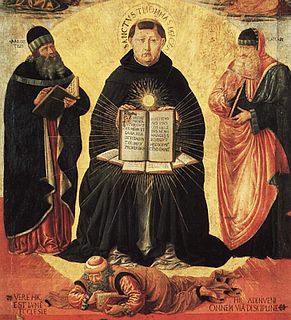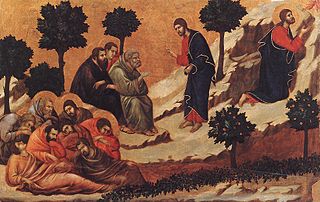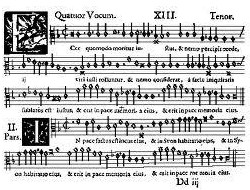
Marc-Antoine Charpentier was a French composer of the Baroque era.

Michel Richard Delalande [de Lalande] was a French Baroque composer and organist who was in the service of King Louis XIV. He was one of the most important composers of grands motets. He also wrote orchestral suites known as Simphonies pour les Soupers du Roy and ballets.
The year 1690 in music involved some significant events.
The Lamentations of Jeremiah the Prophet have been set by various composers.

Panis angelicus is the penultimate strophe of the hymn "Sacris solemniis" written by Saint Thomas Aquinas for the feast of Corpus Christi as part of a complete liturgy of the feast, including prayers for the Mass and the Liturgy of the Hours.
The Leçons de ténèbres pour le mercredi saint are a series of three vocal pieces composed by François Couperin for the liturgies of Holy Week, 1714, at the Abbaye royale de Longchamp.

Psalm 130 is the 130th psalm of the Book of Psalms, one of the Penitential psalms. The first verse is a call to God in deep sorrow, from "out of the depths" or "out of the deep", as it is translated in the King James Version of the Bible and the Coverdale translation respectively. It is one of 15 psalms that begin with the words "A song of ascents". The Book of Psalms is in Ketuvim, the third section of the Hebrew Bible, and is a book of the Christian Old Testament. In the Greek Septuagint version of the Bible, and in the Latin Vulgate, this psalm is Psalm 129 in a slightly different numbering system. In Latin, it is known as De profundis.

Psalm 148 is the 148th psalm of the biblical Book of Psalms. New King James Version provides a header "Praise to the Lord from Creation" to this psalm.
Marc-Antoine Charpentier composed six Te Deums, although only four of them have survived. Largely because of the great popularity of its prelude, the best known is the Te Deum in D major, H. 146, written as a grand motet for soloists, choir, and instrumental accompaniment probably between 1688 and 1698, during Charpentier's stay at the Jesuit Church of Saint-Louis in Paris, where he held the position of musical director.

Michel Lambert was a French singing master, theorbist and composer.

Psalm 13 is the 13th psalm of the Book of Psalms, generally known in English by its first verse, in the King James Version, "How long, O Lord". The Book of Psalms is the third section of the Hebrew Bible, and a book of the Christian Old Testament. In the Greek Septuagint version of the bible, and in its Latin translation in the Vulgate, this psalm is Psalm 12 in a slightly different numbering system. In Latin, it is known as "Usquequo Domine".

Psalm 124 is the 124th psalm of the biblical Book of Psalms. In the Greek Septuagint version of the bible, and in its Latin translation in the Vulgate, this psalm is Psalm 123 in a slightly different numbering system. It is one of fifteen psalms that begin with the words "A song of ascents".
Leçons de ténèbres is a genre of French Baroque music which developed from the polyphonic lamentations settings for the tenebrae service of Renaissance composers such as Sermisy, Gesualdo, Tallis, and Tomás Luis de Victoria into virtuoso solo chamber music.
Judith Anne Nelson, née Manes was an American soprano, noted for her performances of baroque music at the beginning of the "early music revival" of the 1970s and 1980s.

Responsoria et alia ad Officium Hebdomadae Sanctae spectantia is a collection of music for Holy Week by Italian composer Carlo Gesualdo, published in 1611. It consists of three sets of nine short pieces, one set for each of Maundy Thursday, Good Friday and Holy Saturday, and a psalm and a hymn. The work was written for unaccompanied voices: two soprano parts, alto, two tenor parts, and bass.

Tristis est anima mea is a sacred motet for five voices attributed to Johann Kuhnau, Thomaskantor in Leipzig. The text is the second responsory at Tenebrae for Maundy Thursday, one of the Latin texts kept in the liturgy after the town converted to Lutheranism.

Tristis est anima mea is the second responsory of the Tenebrae for Maundy Thursday. The Latin text refers to Christ's Agony in the Garden of Gethsemane, a part of his Passion.

The righteous perishes are the words with which the 57th chapter of the Book of Isaiah starts. In Christianity, Isaiah 57:1–2 is associated with the death of Christ, leading to liturgical use of the text at Tenebrae: the 24th responsory for Holy Week, "Ecce quomodo moritur justus", is based on this text. More generally, the text is associated with the death of loved ones and is used at burials. As such, and in other versions and translations, the Bible excerpt has been set to music.
Sept répons des ténèbres, FP 181, is a piece of sacred music composed by Francis Poulenc in 1961. He wrote the work in seven movements on Latin texts from the Responsories for the Holy Week and scored it for soprano, choir, and orchestra. Written on a commission from the New York Philharmonic, it was first performed in New York's Lincoln Center in April 1963 after the composer's death.
Concerto Vocale is a Belgian musical ensemble for baroque music.











